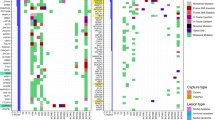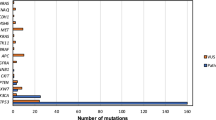Abstract
To investigate whether genetic alteration of the STK11 (serine/threonine kinase 11)/LKB1 tumor-suppressor gene is involved in the carcinogenesis of head and neck squamous cell carcinoma (HNSCC), the entire encoding exons and flanking intronic sequences of the STK11/LKB1 gene were analysed with direct genomic sequencing of 15 HNSCC specimens. A novel missense mutation with presumed loss of heterozygosity (LOH) and 10 polymorphisms were identified in these samples. The novel mutation of STK11/LKB1 at nucleotide position 613 G → A, which causes the amino-acid substitution from alanine to threonine at residue 205 within the catalytic kinase domain, was identified in cell line RPMI 2650. To further determine whether this point mutation affects the gene function, constructs of the wild type and A205T mutant of the STK11/LKB1 gene expression vectors were created and transfected into RPMI 2650 cells. Our results showed that the reintroduction of the wild-type but not the mutant STK11/LKB1 construct into RPMI 2650 cells induced suppression of the cell growth. The mutation also affected the kinase activity of the Stk11/Lkb1 protein. This led us to conclude that the A205T point mutation of the STK11/LKB1 gene produces functionally inactive proteins. This is the first described mutation of the STK11/LKB1 gene in HNSCC. While the mutation frequency of the STK11/LKB1 gene in HNSCC remains to be determined in future studies, our data strongly suggests that STK11/LKB1 is involved in the carcinogenesis of HNSCC.
This is a preview of subscription content, access via your institution
Access options
Subscribe to this journal
Receive 50 print issues and online access
$259.00 per year
only $5.18 per issue
Buy this article
- Purchase on Springer Link
- Instant access to full article PDF
Prices may be subject to local taxes which are calculated during checkout



Similar content being viewed by others
Abbreviations
- HA:
-
hemagglutinin
- HNSCC:
-
Head and neck squamous cell carcinoma
- HRP:
-
horseradish peroxidase
- LOH:
-
loss of heterozygosity
- PJS:
-
Peutz–Jeghers syndrome
References
Avizienyte E, Loukola A, Roth S, Hemminki A, Tarkkanen M, Salovaara R et al. (1999). Am J Pathol 154: 677–681.
Avizienyte E, Roth S, Loukola A, Hemminki A, Lothe RA, Stenwig AE et al. (1998). Cancer Res 58: 2087–2090.
Bardeesy N, Sinha M, Hezel AF, Signoretti S, Hathaway NA, Sharpless NE et al. (2002). Nature 419: 162–167.
Boudeau J, Kieloch A, Alessi DR, Stella A, Guanti G, Resta N . (2003). Hum Mutat 21: 172.
Chen RW, Avizienyte E, Roth S, Elivo I, Makitie AA, Aaltonen LM et al. (1999). J Med Genet 36: 943–944.
Ghaffar H, Sahin F, Sanchez-Cepedes M, Su GH, Zahurak M, Sidransky D et al. (2003). Clin Cancer Res 9: 2998–3003.
Giardiello FM, Brensinger JD, Tersmette AC, Goodman SN, Petersen GM, Booker SV et al. (2000). Gastroenterology 119: 1447–1453.
Giardiello FM, Welsh SB, Hamilton SR, Offerhaus GJA, Gittelsohn AM, Booker SV et al. (1987). N Engl J Med 316: 1511–1514.
Guldberg P, thor Straten P, Ahrenkiel V, Seremet T, Kirkin AF, Zeuthen J . (1999). Oncogene 18: 1777–1780.
Hawley SA, Boudeau J, Reid JL, Mustard KJ, Udd L, Makela TP et al. (2003). J Biol 2: 28.
Hemminki A, Markie D, Tomlinson I, Avizienyte E, Roth S, Loukola A et al. (1998). Nature 391: 184–187.
Hemminki A, Tomlinson I, Markie D, Jarvinen H, Sistonen P, Bjorkqvist AM et al. (1997). Nat Gene 15: 87–90.
Hong SP, Leiper FC, Woods A, Carling D, Carlson M . (2003). Proc Natl Acad Sci USA 100: 8839–8843.
Jenne DE, Reimann H, Nezu J, Friedel W, Loff S, Jeschke R et al. (1998). Nat Gene 18: 38–43.
Jishage K, Nezu J, Kawase Y, Iwata T, Watanabe M, Miyoshi A et al. (2002). Proc Natl Acad Sci USA 99: 8903–8908.
Jordanova A, Kalaydjieva L, Savov A, Claustres M, Schwarz M, Estivill X et al. (1997). Hum Mutat 10: 65–70.
Karuman P, Gozani O, Odze RD, Zhou XC, Zhu H, Shaw R et al. (2001). Mol Cell 7: 1307–1319.
Launonen V . (2005). Hum Mutat 26: 291–297.
Lizcano JM, Goransson O, Toth R, Deak M, Morrice NA, Boudeau J et al. (2004). EMBO J 23: 833–843.
Nakau M, Miyoshi H, Seldin MF, Imamura M, Oshima M, Taketo MM . (2002). Cancer Res 62: 4549–4553.
Ossipova O, Bardeesy N, DePinho RA, Green JB . (2003). Nat Cell Biol 5: 889–894.
Rossi DJ, Ylikorkala A, Korsisaari N, Salovaara R, Luukko K, Launonen V et al. (2002). Proc Natl Acad Sci USA 99: 12327–12332.
Rowan A, Bataille V, MacKie R, Healy E, Bicknell D, Bodmer W et al. (1999). J Invest Dermatol 112: 509–511.
Rowan A, Churchman M, Jefferey R, Hanby A, Poulsom R, Tomlinson I . (2000). J Pathol 192: 203–206.
Sanchez-Cespedes M, Parrella P, Esteller M, Nomoto S, Trink B, Engles JM et al. (2002). Cancer Res 62: 3659–3662.
Shaw RJ, Bardeesy N, Manning BD, Lopez L, Kosmatka M, DePinho RA et al. (2004a). Cancer Cell 6: 91–99.
Shaw RJ, Kosmatka M, Bardeesy N, Hurley RL, Witters LA, DePinho RA et al. (2004b). Proc Natl Acad Sci USA 101: 3329–3335.
Smith DP, Rayter SI, Niederlander C, Spicer J, Jones CM, Ashworth A . (2001). Hum Mol Genet 10: 2869–2877.
Spicer J, Rayter S, Young N, Elliott R, Ashworth A, Smith D . (2003). Oncogene 22: 4752–4756.
Su GH, Hruban RH, Bansal RK, Bova GS, Tang DJ, Shekher MC et al. (1999). Am J Pathol 154: 1835–1840.
Suzuki A, Kusakai G, Kishimoto A, Shimojo Y, Ogura T, Lavin MF et al. (2004). Biochem Biophys Res Commun 324: 986–992.
Tiainen M, Ylikorkala A, Makela TP . (1999). Proc Natl Acad Sci USA 96: 9248–9251.
Westerman AM, Entius MM, Boor PP, Koole R, de Baar E, Offerhaus GJ et al. (1999). Hum Mutat 13: 476–481.
Ylikorkala A, Rossi DJ, Korsisaari N, Luukko K, Alitalo K, Henkemeyer M et al. (2001). Science 293: 1323–1326.
Acknowledgements
This work was supported by the NCI Temin Award CA95434 and the NCI R01 CA109525.
Author information
Authors and Affiliations
Corresponding author
Rights and permissions
About this article
Cite this article
Qiu, W., Schönleben, F., Thaker, H. et al. A novel mutation of STK11/LKB1 gene leads to the loss of cell growth inhibition in head and neck squamous cell carcinoma. Oncogene 25, 2937–2942 (2006). https://doi.org/10.1038/sj.onc.1209325
Received:
Revised:
Accepted:
Published:
Issue Date:
DOI: https://doi.org/10.1038/sj.onc.1209325
Keywords
This article is cited by
-
STK11 mutation status is associated with decreased survival in meningiomas
Neurological Sciences (2020)
-
TP53 Polymorphism Contributes to the Susceptibility to Bipolar Disorder but Not to Schizophrenia in the Chinese Han Population
Journal of Molecular Neuroscience (2019)
-
Frequent chromosomal aberrations and candidate genes in head and neck squamous cell carcinoma
European Archives of Oto-Rhino-Laryngology (2016)
-
Tongue carcinoma infrequently harbor common actionable genetic alterations
BMC Cancer (2014)
-
Novel mutations and role of the LKB1 gene as a tumor suppressor in renal cell carcinoma
Tumor Biology (2014)



